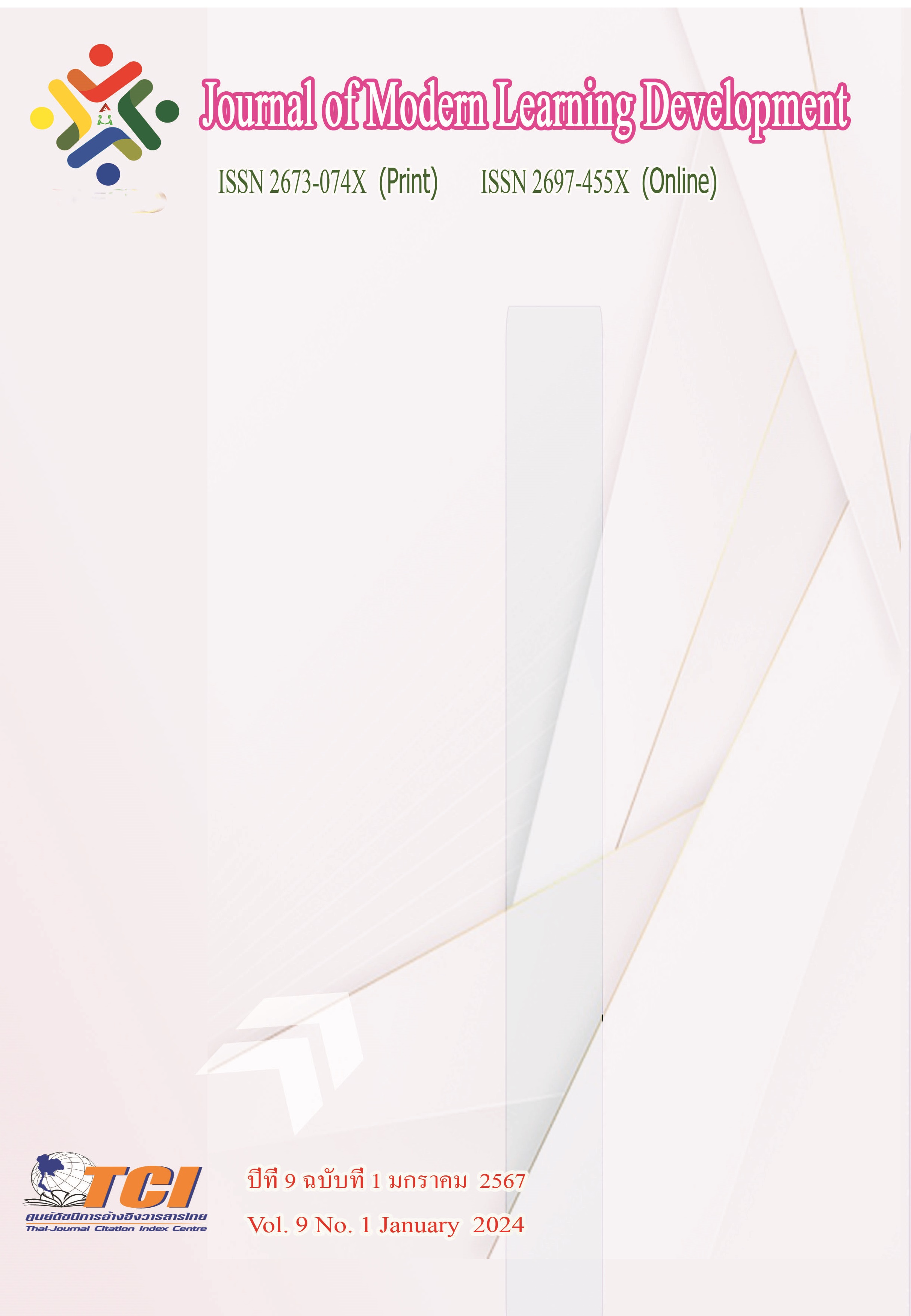The Factors Affecting the Learning Loss of Upper Primary School Students Under the Office of Phitsanulok Primary Education Service Area Office 3
Main Article Content
Abstract
The objective of this study was to investigate The Factors Affecting The Learning Loss of Upper Primary School Students Under the Office of Phitsanulok Primary Education Service Area Office 3 to study the relationship of factors affecting learning loss among high school students. Under the Office of Phitsanulok Primary Education Area Area 3 and to create equations to predict factors that affect Learning Loss of Upper Primary School Students Under the Office of Phitsanulok Primary Education Service Area Office 3, the sample used in this research was high school students. Under the Phitsanulok Primary Education Area Office, District 3, Semester 2, Academic Year 2022, 390 students using the Multistage random sampling method. It is a 5-level estimation scale, analyzing data by averaging standard deviations. Pearson correlation coefficient and enter multiple regression analysis.
The results of the research were as follows:
1. The Factors Affecting The Learning Loss of Upper Primary School Students Under the Office of Phitsanulok Primary Education Service Area Office 3 overall averages moderately. Considering each aspect. The factor with the highest average was parental engagement (X4), followed by the learning environment (X5), and the lowest average factor was educational opportunity (x1).
2. The Stepwise Multiple Regression Analysis of factors affecting learning loss found that educational opportunities (X1), self-regulation in learning (X2), and learning management (X3) affect learning loss Statistically significant at a level of .05 with a multiple correlation coefficient (R) of .396, a predictive power value ( ) of .157, a threshold variable of 15.7% can be explained.
Zy = - 0.298X2* - 0.283X3* - 0.195X1*
Article Details
References
ธานินทร์ ศิลป์จารุ. (2555). การวิจัยและวิเคราะห์ข้อมูลทางสถิติด้วย SPSS (Vol. พิมพ์ครั้งที่ 11).
กรุงเทพมหานคร บิสซิเนสอาร์.
พวงรัตน์ ทวีรัตน์. 2540. วิธีการวิจัยทางพฤติกรรมศาสตร์และสังคมศาสตร์. (พิมพ์ครั้งที่ 7). กรุงเทพมหานคร:
สำนักทดสอบทางการศึกษาและจิตวิทยา มหาวิทยาลัยศรีนครินทร์วิโรฒประสานมิตร.
ภูมิศรัณย์ ทองเหลี่ยมนาค. (2564). สำรวจผลกระทบ COVID-19 จุดเปลี่ยนครั้งสำคัญของ
การศึกษาโลก. สืบค้น 13 กันยายน 2565, จาก https://www.eef.or.th/article1-02-01-211/.
ลัดดาวัลย์ เพชรโรจน์ และอัจฉรา ชำนิประศาสน์. (2545). ระเบียบวิธีการวิจัย. กรุงเทพมหานคร: พิมพ์ดี.
สถาบันวิจัยเพื่อความเสมอภาคทางการศึกษา (วสศ.). (2022). Learning Loss ภาวะการเรียนรู้ถดถอย. สืบค้นเมื่อ 11 สิงหาคม 2565, จาก https://research.eef.or.th/learning-loss-recession/
สำนักงานเขตพื้นที่การศึกษาประถมศึกษาพิษณุโลก เขต 3. (2565). แนวทางแก้ไขภาวะ
ถดถอยทางการเรียนรู้ สำนักงานเขตพื้นที่การศึกษาประถมศึกษาพิษณุโลก เขต 3. สืบค้น
เมื่อ 11 สิงหาคม 2565. แหล่งที่มา: https://online.pubhtml5.com/aezk/nnok/index.html #p=1.
สำนักงานเลขาธิการสภาการศึกษา. (2564). การศึกษาภาวะถดถอยทางการเรียนรู้ของผู้เรียนระดับการศึกษาขั้นพื้นฐานในสถานการณ์โควิด-19. มหาวิทยาลัยศรีนครินทรวิโรฒ.
อัจฉรีย์ ทิพธนธรณินทร์ และ สมบูรณ์ ศิริสรรหิรัญ. (2556). ความเท่าเทียมทางการศึกษารากฐานการ
พัฒนาการศึกษาไทยสู่สากล. วารสารการเมืองการปกครอง. 3 (2), 194-208.
Emma Dorn, Bryan Hancock, Jimmy Sarakatsannis, and Ellen Viruleg. (December 8,
. COVID-19 and learning loss—disparities grow and students need help.
McKinsey Global Publishing. Online. Retrieved August 11, 2022, from https://www.
mckinsey.com/industries/public-and-social-sector/our-insights/covid-19-and-learning-loss-disparities-grow-and-students-need-help.
Harry Anthony Patrinos Emiliana Vegas and Rohan Carter-Rau. (May 2022). An Analysis
of COVID-19 Student Learning Loss. Policy Research Working Paper 10033.
Online. Retrieved August 11, 2022, from https://openknowledge.worldbank.org/server
/api/core/bitstreams/2f5687e1-25a0-5d2d-9e41-29aa5d172ae0/content.
Poornima Sayeejan and Ananthamyl Nithlavarnan. (2018). Learning loss and learning difficulties of junior secondary students in science subject due COVID 19 OUTBREAK, The Sri Lanka Journal of South Asian Studies. 4 (1), 21-38.
Sergei P. Zhdanov Kseniia M. Baranova Natalia Udina Artem E. Terpugov Elena V.
Lobanova and Oksana V. Zakharova. (2022). Analysis of Learning Losses of
Students During the COVID-19 Pandemic. Contemporary Educational
Technology. 14 (3), ep369.
Tashmina Rahman and Uttam Sharma. (January 2021). A SIMULATION OF COVID-19 SCHOOL CLOSURE IMPACT ON STUDENT LEARNING IN BANGLADESH. The World Bank. Retrieved August 11, 2022, from https://openknowledge.worldbank. org/server/api/ core/bitstreams/7920fbdb-db09-50e2-953d-e9c1c1fef4b1/content.
Tessa M. Schuurman, Lotte F. Henrichs, Noémi K. Schuurman, Simone Polderdijk & Lisette Hornstra. (2021). Learning Loss in Vulnerable Student Populations After the First Covid-19 School Closure in the Netherlands. Scandinavian Journal of Educational Research, 67(2), 309-326.
Trias, D., Huertas, J. A. ., Mels, C. ., Castillejo, I., & Ronqui, V. (2021). Self-regulated learning, academic achievement and socioeconomic context at the end of primary school. Revista Interamericana De Psicología/Interamerican Journal of Psychology, 55 (2), e1509.


